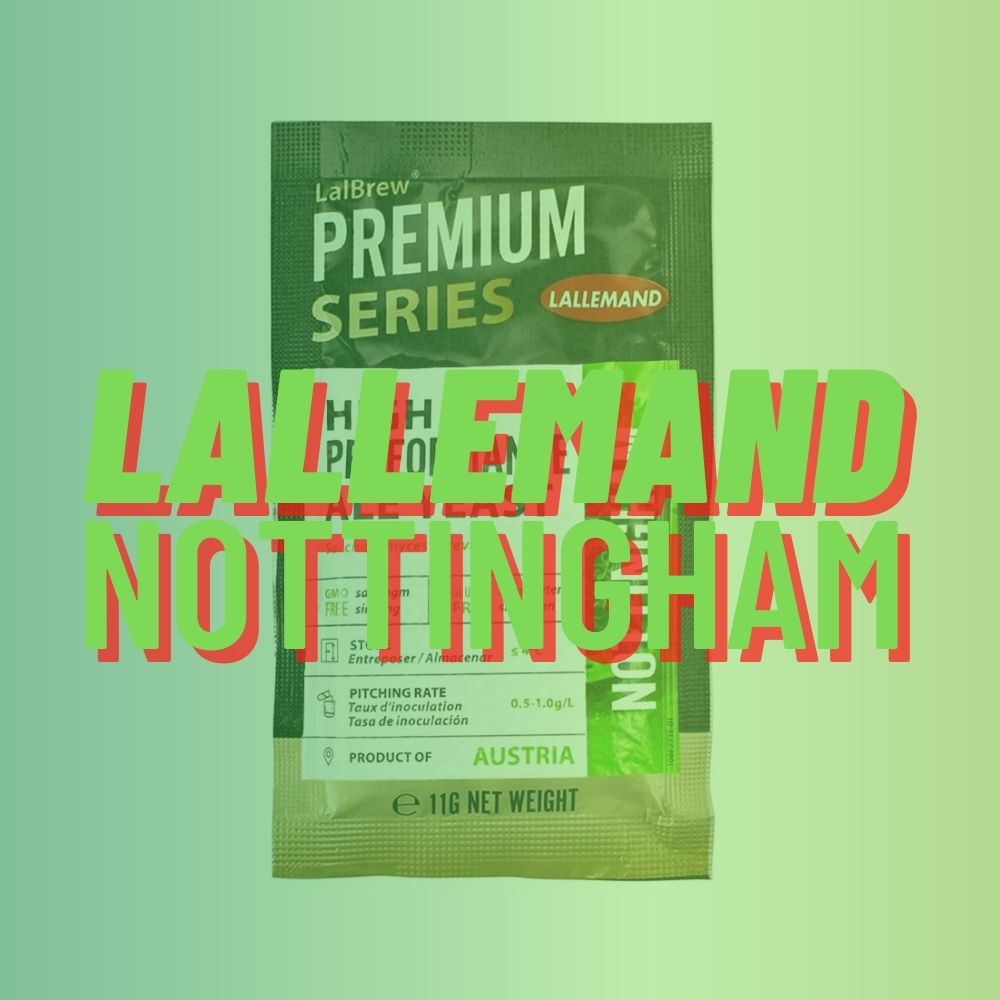Lallemand Nottingham Yeast – Complete Guide To Nottingham Yeast

Nottingham yeast is one of the most versatile and popular yeast strains on the market for homebrewers.
Nottingham is a dry yeast strain produced by Lallemand, it has a clean and neutral profile and is synonymous with English style beers. It is a proven fast and quick fermenter and can finish quite dry even in higher alcohol beers.
Part of the versatility of Nottingham is due to the fact it works in so many styles of beer and performs consistently. If there was an easy way to describe the character it would be neutral and this may be one of the reasons why it is one of the most common yeast strains on the market.
Table of Contents
Nottingham Yeast Profile
Lallemand Nottingham is a dry yeast that has a neutral flavour and aroma, excellent attenuation and good flocculation.
Nottingham Attenuation
This yeast strain is widely known as a strong fermenter with good attenuation.
Attenuation is the degree to which a yeast strain will ferment the sugar available on the wort. The attenuation is expressed as a percentage so 60% attenuation would indicate that 60% of the sugar has been converted to alcohol and 40% remains in the beer.
Nottingham yeast typically has a high attenuation ranging from 75 – 85% or more. Attenuation will be affected by the type of beer being brewed with higher gravity beers having a lower level of attention.
Neutral Flavour Profile
All yeast produce flavour and aroma compounds and esters that will contribute to the flavour of the finished beer.
Nottingham yeast has a clean and neutral profile and will produce slight fruity and peppery esters although these will be subtle. Neutral yeasts like Nottingham allow the malt and hops to take centre stage without contributing too much flavour of its own.
Nottingham Flocculation
Nottingham yeast will typically produce bright, clear beers relatively quickly. It has high levels of flocculation.
Flocculation refers to the habit of yeast clumping together after fermentation. High flocculating yeasts will quickly attract themselves together which encourages them to sediment onto the bottom of the fermenting vessel leaving a clear beer.
Key Figures For Lallemand Nottingham
Fermentation Temperature: ideally 10-22°C (50-72°F)
Flocculation: High
Attenuation: High
Alcohol Tolerance: up to 14% ABV
Yeast Cell Count: > 55,000,000,000 (55 billion) per 11g sachet
Nottingham Yeast Beer Styles
The versatility and neutral profile of Nottingham mean it is a suitable yeast for many beer styles.
Most English beer styles call for yeast that produces subtle esters and the alcohol tolerance of Nottingham means you could consider the following range of beer styles:
Pale ales, IPA, Amber, Brown Ale, Mild, Stout, Porter, Old Ale, Barleywine.
The temperature range the Nottingham yeast works in means that you can drop fermentation temperatures down to around 10°C / 50°F and produce lager-like beers with crisp and clean profiles. This opens up styles like Kolsch, Golden ales and lager-like beers.
Nottingham Yeast Origins
It is unclear where the original yeast strain originated. The name Nottingham refers to a city in Englands midland region.
All notable breweries in Nottingham where the strain may have been sourced have closed.
It may be that the strain was originally sourced from the yeasts provided with homebrew kits stocked at pharmacists at the time. It is also notable that Boots pharmacy, which sold homebrew kits in the 1970s is headquartered in Nottingham.
Pitching Nottingham Yeast
Lallemand gives clear instructions that Nottingham can be pitched directly into wort or you can rehydrate the yeast in sterile water which will cause the yeast less stress.
There is no instruction to aerate wort or provide additional nutrients as Lallemand states the yeast have been conditioned to survive rehydration either pitching directly or rehydrating in sterile water.
The recommendation for 0.5 – 1g per litre of beer means that 1 sachet of 11g is enough for a 20 litre batch on the lower end of this recommendation.
Direct Pitching Nottingham
The easiest method of pitching this yeast is to simply sprinkle it onto the surface of the cooled wort or into the wort as the fermenter is being filled. Keep the temperature of the wort going into the fermenter the same as your desired fermentation temperature to avoid stressing the yeast.
Rehydrating Nottingham
Rehydrating yeast might be a better option if you are concerned about high ABV beers or want a really neutral profile in the beer as the yeast cells will be less stressed than direct pitching.
Lallemand instructions are complicated because they are intended for commercial brewers, they are as follows:
Stir gently, leave undisturbed for 15 minutes, then stir to suspend yeast completely. Leave it to rest for 5 more minutes at 30-35°C (86-95°F) for ale yeasts and 25-30°C (77-86°F) for lager yeasts. Lallemand
The next steps involve attemperating the rehydrated yeast to the wort temperature. As the volumes for homebrewers are a lot smaller attemperation will occur naturally within 15 minutes so you can pitch the rehydrated yeast slurry straight into the wort.
A simple set of rehydration instructions can be found here is you are unsure of what to do.




Leave a Reply
Want to join the discussion?Feel free to contribute!